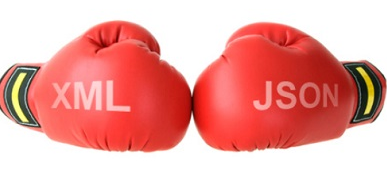
JSON vs. XML
Both JSON and XML are capable of representing in-memory data in a readable textual format. Similarly, both of them are isomorphic, which means an equivalent one of the given piece of text is possible in the other format. For instance, while invoking a public Web service, a developer can state in the query string parameter whether the output should be in XML or JSON format.
Due to such similarities, it might not be simple to choose a suitable data exchange format from the two. This is where it is essential to consider the differentiating characteristics or both the formats and find out which one is more suitable for a particular application.
Compares the major characteristics of both formats.
|
Characteristic |
JSON |
XML |
|
Data Types |
Offers scalar data types and articulates structured data in the form of objects and arrays |
Does not offer any idea of data types due to which relying on XML Schema is essential for specifying information about the data types. |
|
Array Support |
Provides native support |
Expresses array by conventions. For instance, XML employs an outer placeholder element that forms the content in an array as inner elements. |
|
Object Support |
Provides native support |
Expresses objects by conventions, usually by combining attributes and elements. |
|
Null Support |
Recognizes the value natively. |
Mandates the use of xsi:nil on elements in an instance document along with the import of the related namespace. |
|
Comments |
Does not support |
Provides native support (via APIs). |
|
Namespaces |
Does not support namespaces and that naming collisions do not occur, as objects are nested or the object member name has a prefix. |
Accepts namespaces to prevent name collisions and safely extent the prevalent XML standards. |
|
Formatting |
Is simple and offers more direct data mapping |
It complex and needs more effort for mapping application types to elements. |
|
Size |
Has very short syntax, which gives formatted text wherein most space is taken up by the represented data. |
Has lengthy documents, particularly in case of element-centric formatting. |
|
Parsing in JavaScript |
Has very short syntax, which gives formatted text wherein most space is taken up by the represented data. |
Has lengthy documents, particularly in case of element-centric formatting. |
|
Parsing in JavaScript |
Needs no additional application for parsing (JavaScript’s eval() function work well ). |
Implements XML DOM and requires extra code for mapping text to JavaScript objects. |
|
Parsing |
Has JSONPath for selecting specific sections of the data structure but is not widely used. |
Has XPath specification for doing the same in an XML document and is widely used.
|
|
Learning Curve |
Is not sleep at all, due to familiarity with the structure and the underlying dynamic programming language. |
Is steep with the need to know several technologies and concepts such as XPath, XSL Transformations (XSLT), DOM, Schema, and Namespaces. |
|
Complexity |
Is complex |
Is more complex. |
|
Schema (Metadata) |
Has a schema but is not widely used. |
Used many specifications for defining a schema, including XML Schema Definition (XSD) and Document Type Definition (DTD) |
|
Styling |
Has no special specification. |
Has XSLT specification for styling an XML document. |
|
Security |
Is less secure, as the browser has no JSON parser. |
Is more secure. |
